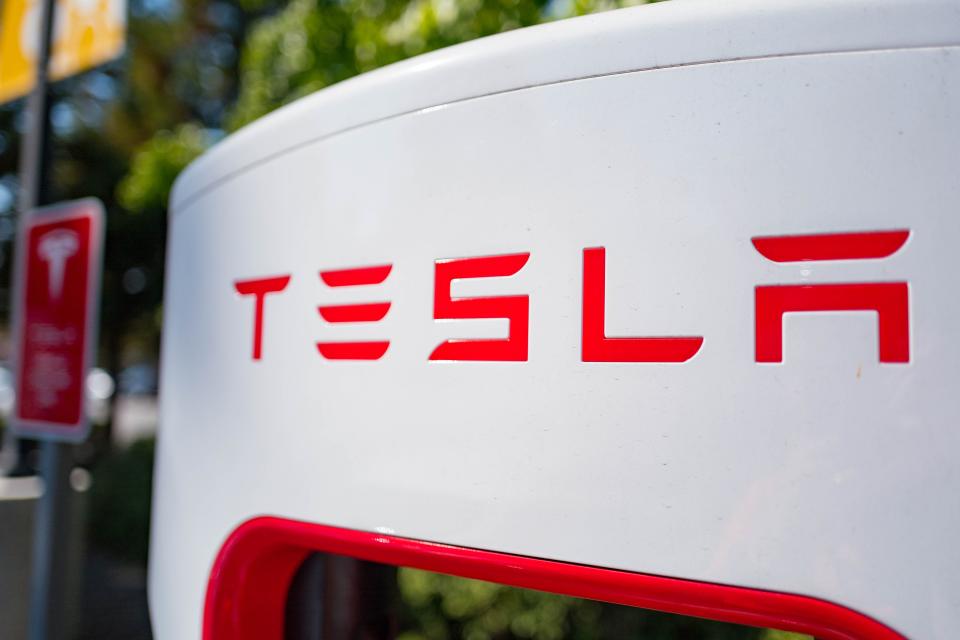Tesla bulls dig in their hooves after company’s $5 billion capital raise announcement

Tesla certainly knows how to strike when the iron is hot.
The Elon Musk-led electric vehicle behemoth saw a 13% surge from bullish investors and traders on Monday following its 5-for-1 stock split— building on roaring momentum that’s seen the stock skyrocket 479% this year.
But Tesla isn’t stopping there: early Tuesday, the company announced a capital raise of up to $5 billion worth of shares via 10 top banks including Goldman Sachs and Citigroup, selling them “from time to time, through an ‘at-the-market’ offering program,” the company said in an SEC filing.
And Tesla bulls are seemingly digging their hooves in deeper.
“I think this was purely a golden opportunity to shore up its balance sheet and just given the massive momentum in shares, it was the right move at the right time because now they’re no longer in a negative debt situation relative to its balance sheet,” Wedbush’s ever-bullish Dan Ives tells Fortune.
Currently Tesla holds about $14.1 billion in total debt and finance leases and roughly $8.6 billion in cash (as of its latest 2nd quarter report).
Although the stock was trading down roughly 2% in midday trading Tuesday, for investors, “this just puts further credence in the longer-term bullish thesis for Tesla,” Ives argues. “I think it really takes the lingering bear thesis around the balance sheet and debt situation and throws it out the window.”
Naturally, Tesla bulls haven’t been shy on Twitter.
$TSLA is unstoppable! To the Moon!!! 🚀🚀🚀🚀🛸 pic.twitter.com/Kp8L4JOGIQ
— TradingFyra (@TradingFyra) September 1, 2020
This latest capital raise comes six months after the EV maker raised some $2 billion in a stock offering—moves that “initially took the doomsday scenario off the table that Tesla was facing at the time and ultimately helped them navigate the build out of the linchpin Giga 3 factory in China and enough time for the model to hit sustained profitability,” Ives wrote in a note Tuesday.
The ‘champagne on ice for S&P 500 inclusion’
Meanwhile, inclusion in the S&P 500 index has been an increasingly hot topic for Tesla investors, and according to some bulls, this latest one-two punch of the stock split and capital raise “basically puts the champagne on ice for S&P inclusion,” Wedbush’s Ives believes. Inclusion would be “important institutionally-speaking,” Ives says, as he notes institutional interest in the stock has grown in recent months, and he believes inclusion is now a “matter of when, not if.”
Yet less bullish voices on the Street view Tesla’s hype as a bit overdone.
“Tesla will have growing pains, recessions to fight through before reaching mass-market volume, more competition, and needs to pay off debt,” Morningstar’s David Whiston wrote in an August 25 note. “It is important to keep the hype about Tesla in perspective relative to the firm’s limited, though now growing, production capacity.”
That debt, at least, may be tended to via the company’s newest capital raise, but Morningstar’s Whiston believes there are some bigger issues: “We do not see [Tesla] having mass-market volume this decade. Tesla’s product plans for now do not mean an electric vehicle for every consumer who wants one, because the prices are too high,” he writes.
Meanwhile, the question of if Tesla deserves its sky-high valuation is increasingly at the fore—And according to longtime short-seller Jim Chanos of Kynikos Associates, “Tesla’s not a market leader. The product at Tesla that’s always been first-rate is the narrative,” he recently told Fortune.
Yet following the company’s stock split on Monday, analysts like Morningstar’s Whiston have updated their tune somewhat: he believes Tesla’s “ability to make desirable vehicles while generating free cash flow and net profit is far better than it’s ever been, in our opinion,” Whiston wrote Monday, and notes that “for a young company like Tesla, we think long-term potential is the more important question and value driver than how many Model 3 or Model Ys get delivered in a quarter.”
Ives is willing to go even further: His bull-case-scenario sees Tesla popping over 40% higher from Monday’s close.
More must-read finance coverage from Fortune:
Investors are pouring record amounts into Wall Street’s new favorite “safe haven”
First he took energy trading and the NYSE electronic. Now Jeff Sprecher of ICE shares his plans to digitize your mortgage
The bizarre reason Amazon drivers are hanging phones in trees near Whole Foods
The humbling of Europe’s most-hyped startup incubator: Rocket Internet
Fortune’s 2020 40 Under 40
This story was originally featured on Fortune.com
